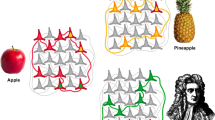Abstract
In this paper we study the role of supervised and unsupervised neural learning schemes in the adaptive control of nonlinear dynamic systems. We suggest and demonstrate that the teacher's knowledge in the supervised learning mode includes a-priori plant sturctural knowledge which may be employed in the design of exploratory schedules during learning that results in an unsupervised learning scheme. We further demonstrate that neurocontrollers may realize both linear and nonlinear control laws that are given explicitly in an automated teacher or implicitly through a human operator and that their robustness may be superior to that of a model based controller. Examples of both learning schemes are provided in the adaptive control of robot manipulators and a cart-pole system.
Similar content being viewed by others
Explore related subjects
Discover the latest articles, news and stories from top researchers in related subjects.References
Barto A.G., Sutton R.S., and C.W. Anderson, Neuronlike adaptive elements that can solve difficult learning control problems. IEEE Trans. Systems Man Cybernet., bSM
Fu, K.S., Gonzales, R.C., and Li, C.S.G., Robotics: Control Sensing, Vision, and Intelligence, McGraw-Hill, 1987.
Guez, A., Eilbert, J., and Kam, M., Neuromorphic architecture for control, IEEE Control Systems Magazine, April 1988.
Guez, A., and Selinsky J., A trainable neuromorphic controller. J. Robotics Systems August 1988.
Guez, A., Optimal control of robotic manipulators, PhD Thesis, Univ. of Florida, Gainesville, Florida, 1982.
Guez, A., and Boykin, W.H., Manual tracking modeling and analysis of a helicopter borne precision laser pointing system, System Dynamics Incorporated, Technical Report 82-5, 1982.
Kawato, M., Furukawa, K., and Suzuki, R., A hierarchical neural-network model for control and lerning of voluntary movement, Biological Cybernetics 56.
KwakernaakH. and SivanR., Linear Optimal Control Systems, Wiley, New York, 1972.
PaulR.P., Robot Manipulators: Mathematics, Programming and Control, MIT Press, Mass., 1981.
Psaltis, D., Sideris, A., and Yamamura, A., Neural controllers, Proc. IEEE First International Conference on Neural Networks, San Diego, 1987.
RumelhartD., HintonG.E., and WilliamsR.L., Learning internal representations by error propagation, in D.E.Rumelhart and J.L.McClelland (eds.), Parallel Distributed Processing: Explorations in the Microstructure of Cognition. Vol. 1: Foundations, MIT Press, Mass, 1986.
Selinsky, J., Closed loop learning of rigid robot dynamics via design of exploratory schedules, MS thesis, Drexel Univ., Philadelphia, PA, 1989.
Slotine, J.J. and Li, W., Adaptive manipulator control: a case study, Proc. IEEE Robotics and Automation Conference, Rayleigh N.C., 1987.
Widrow, B. and Smith, F.W., Pattern recognizing control systems, 1963 Computer and Information Sciences Symposium Proceedings, Washington, DC, 1964.
Widrow, B. The original adaptive broom balancer, IEEE Conference on Circuits and Systems, Philadelphia PA, 1987.
Author information
Authors and Affiliations
Rights and permissions
About this article
Cite this article
Guez, A., Selinsky, J. Neurocontroller design via supervised and unsupervised learning. J Intell Robot Syst 2, 307–335 (1989). https://doi.org/10.1007/BF00238695
Received:
Issue Date:
DOI: https://doi.org/10.1007/BF00238695




